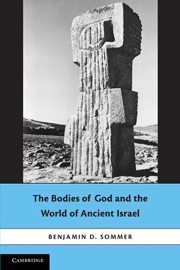Book contents
- Frontmatter
- Contents
- Preface
- Acknowledgments
- Introduction: God's Body and the Bible's Interpreters
- 1 Fluidity of Divine Embodiment and Selfhood: Mesopotamia and Canaan
- 2 The Fluidity Model in Ancient Israel
- 3 The Rejection of the Fluidity Model in Ancient Israel
- 4 God's Bodies and Sacred Space (1): Tent, Ark, and Temple
- 5 God's Bodies and Sacred Space (2): Difficult Beginnings
- 6 The Perception of Divinity in Biblical Tradition: Implications and Afterlife
- Appendix: Monotheism and Polytheism in Ancient Israel
- Notes
- List of Abbreviations
- Bibliography
- Scriptural Index
- Index of Rabbinic Citations
- Subject Index
4 - God's Bodies and Sacred Space (1): Tent, Ark, and Temple
Published online by Cambridge University Press: 15 September 2009
- Frontmatter
- Contents
- Preface
- Acknowledgments
- Introduction: God's Body and the Bible's Interpreters
- 1 Fluidity of Divine Embodiment and Selfhood: Mesopotamia and Canaan
- 2 The Fluidity Model in Ancient Israel
- 3 The Rejection of the Fluidity Model in Ancient Israel
- 4 God's Bodies and Sacred Space (1): Tent, Ark, and Temple
- 5 God's Bodies and Sacred Space (2): Difficult Beginnings
- 6 The Perception of Divinity in Biblical Tradition: Implications and Afterlife
- Appendix: Monotheism and Polytheism in Ancient Israel
- Notes
- List of Abbreviations
- Bibliography
- Scriptural Index
- Index of Rabbinic Citations
- Subject Index
Summary
In the introduction, i defined a body as something located in a particular place at a particular time, whatever its shape or substance. It follows that if God has a body, then at any moment some place enjoys a privilege that other places lack. Consequently, the question of divine embodiment carries weighty implications for the issue of sacred space. Different attitudes toward sacred space, furthermore, should emerge in the fluidity and nonfluidity traditions. We see in this chapter and the next that texts associated with the fluidity traditions regard many spots as sacred and hence undermine a religious ideology that exalts a single sacred center. The antifluidity traditions known from priestly and deuteronomic literature, in contrast, insist on the existence of a unique sacred center, but surprisingly, each of them also undercuts an ideology of the sacred center as well. These attitudes toward sacred space become evident in several ways. In this chapter, I examine attitudes in Pentateuchal sources toward the tent of meeting (or tabernacle), the temple, and the ark to see how their different understandings of sacred space reflect their different perceptions of divine embodiment. In Chapter 5, I examine texts that focus on the theme of place in narratives of origin.
THE TENT OF MEETING IN P AND IN E
Both priestly and nonpriestly texts in the Pentateuch describe a tent in which the divine manifests itself.
- Type
- Chapter
- Information
- The Bodies of God and the World of Ancient Israel , pp. 80 - 108Publisher: Cambridge University PressPrint publication year: 2009



